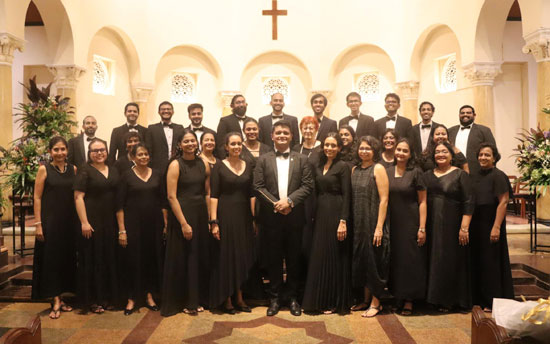A challenging variety under the able baton of Harin
View(s):“The arms of the conductor, like great wings, shape the singing.” -Kim André Arnesen
It was fitting that the Colombo Philarmonic Choir should return to performing at the Chapel of the Hope of the World at Ladies’ College; Harin Amirthanathan took over the baton as conductor of the Choir in 2018, had his debut concert there as conductor and performed a work by Randall Thompson. On June 1, 2025 the Choir and Harin revived the work at the same venue.
Often it is a challenge to present a variety of versatile works as a choral spectrum so it works to hinge it on a theme which binds the concert as a whole. In this instance, the theme of Light and Hope to celebrate 70 years of the Colombo Philarmonic Choir. The well crafted programme included a range of composers from Fauré to Healey Willian, and Brahms to contemporary names such as Whitacre, Elberdin and Arnesen.

Stepping into 70: The Colombo Philharmonic Choir at the Ladies’ College Chapel
Lux Aeterna of Morten Laurisden fame, set the stage for illuminance in a challenging but rewarding choral work usually for a large choir and a full orchestra. Illuminance, often referred to in liturgical music and requiems, signifies the light of eternal life and more generally to a lasting or everlasting light, symbolic of hope, memory or connection. Each of the five connected movements in this choral cycle contains references to ‘Light,’ assembled from a variety of sacred Latin texts set to music and presenting a universal symbol of illumination at all levels – spiritual, artistic and intellectual.
The work opens and closes with the beginning and ending of the Requiem Mass, with the central three movements drawn respectively from the Te Deum, O Nata Lux, and Veni, Sancte Spiritus. The instrumental introduction to the Introitus softly recalls motivic fragments which recur throughout the work. Several new themes in the lntroitus are then introduced by the chorus, including an extended canon on et lux perpetua.
The varied visceral and emotional effects that flowed from the choir caressed and filled the space with a crescendo of shimmering sound. The choir rose to the challenge of performing this monumental work and were well supported by piano and cello. The brilliance of the music shone through with lyrical beauty, emotional depth and spiritual resonance.
Fauré’s most famous romantic rapturous song Après un rêve, is based on a French adaptation of an anonymous Italian text describing a dream of a lover’s romantic rendezvous, an awakening and longing to return to the mysterious night. It was described with great effect by the pause of sensitive rendition of Fauré’s cello interlude excellently captured by Tamara Holsinger with Dilan Angunawala on the piano, setting the stage for the magnificent Lux Aurumque.
Whitacre, a giant in his own right, presents works of emotional architecture, creating a visual through an emotional journey. He conveys teaching the audience breathing, this element capturing and connecting the audience to the choir. The choir delivered excellent renditions of crescendo, decrescendo – the expression of the music, – the musical motif swells and recedes so by measure nine you are matching your breathing with the music. The artfully managed powerful climaxes delivered through a sense of refinement and control.
Brahms’ cycle Vier Quartette (“Four Quartets”) op. 92 for voices and piano, setting four poems by Goethe, Daumer, Allmers, and Hebbel, is about the romantic night atmosphere, melancholy reflections on autumn, and secret noctural amorous adventures. In addition to featuring each voice part, this part song contains many of Brahms’s compositional trademarks: luxurious piano scoring by Dilan, superb vocal writing, variation, text painting, hemiola, duple vs. triple rhythms, even a double inverted canon! A sensitive marriage of text and music. A masterful choral repertory so well delivered.
Elberdin’s Izar ederrak of celestial imagery challenges the choir through eight parts of complex and interesting harmonic choices and their masterful delivery was full and engaging.
The concert ended with a soulful rendition of Danny Boy. Apparently a favourite of Philharmonic’s founder Dr Gerald Cooray, the melancholic presentation of the much loved work dwelt on the symbolism of the close of day, flitting artfully between sadness and optimism through careful and sensitive delivery by the choir. And of course, a fitting finale which was rousing, ending on the highest note of the big chorus of ‘come ye back’.
Working with a theme holds one within the spectrum of a variety of works of light and iridescence, the choir ably led by Harin, shone. A musical laurel well worth resting on.
Concerts to look forward to during the 70th jubilee year are a choral evensong led by Gregory Rose on August 20 and the Lord Nelson Mass of Haydn in partnership with the Chamber Music Society of Colombo on October 12.
-Shalini Wickramasuriya
Searching for an ideal partner? Find your soul mate on Hitad.lk, Sri Lanka's favourite marriage proposals page. With Hitad.lk matrimonial advertisements you have access to thousands of ads from potential suitors who are looking for someone just like you.


